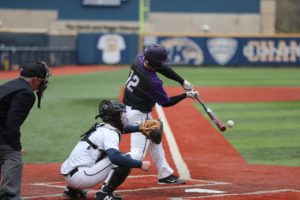Head to any major league or college baseball game and you are likely to notice big ‘K’ signs behind home plate.
Look a little closer and you will see some of the K’s are backward.. which can be confusing if you aren’t a big baseball fan.
So, what does a backward K in baseball mean?
A backward K means that the batter struck out looking, which means that the batter did not swing the bat and the pitcher threw the ball for a called third strike by the umpire which results in a backward K in the official baseball scoring.
Contents
- History of the Backwards K baseball scoring
- 5 ways that generate the most backward K’s
- Why is a called third strike called a letter K?
- Who has the most strikeouts in MLB history?
- When did the called strike backward K start to be used?
- What are the different strikeout nicknames?
- Is the backwards K used in softball and baseball?
- Is there more forward or backward Ks?
- Backward K in Baseball Conclusion
History of the Backwards K baseball scoring
According to MLB.com, before 1858 strikeouts required the batters to swing and miss 3 times in order to record an out.
The use of “K” for the strikeout was originated from Henry Chadwick who is credited with the use of the original box score and the Chadwick created the first baseball scorecard.
The rule was changed to allow umpires to call a third strike and the rule hasn’t changed since.
Read on below to get more background on the backward K:
5 ways that generate the most backward K’s
Here are some of the top reasons pitchers generate backward K’s:
Deception
Deceptive pitchers that have unique arm angles or tough-to-pick-up deliveries can result in a fair amount of backward K’s than a swinging strikeout from pitchers that do not have deception.
Hitters have less than a second to react to a fastball, which means that any additional element of deception the pitcher uses to make the ball difficult to pick up makes it that much harder to pick up out of the pitcher’s hand.
Sharp breaking balls
Pitchers with a sharp curveball or slider have a high amount of backward K’s because of the amount of movement the balls break into the strike zone.
Hitters may see the ball out of the pitcher’s hand and think it looks like a high fastball, but then the ball breaks downward with a sharp spin rate and head down into the strike zone.
Some pitchers have breaking balls that are so sharp it causes the hitter’s knees to buckle and duck as the ball appears to be headed to the batter’s head.
These breaking balls are referred to as “Knee Buckling” sliders or curveballs as a result. Here is a good video of a knee-buckling curveball from one of the pitchers with the best breaking balls:
Bad umpires
Another big cause of backward K’s is bad umpires that call strikes that are actually balls.
Baseball has been reluctant to implement technology into the strike-calling part of the game and as a result, there is still a great deal of human error from umpires behind the plate.
With pitchers throwing in the upper 90s with regularity mistakes are going to be made by umpires from time to time and a missed call will result in a pitch that is a ball being called a strike from time to time.
A catcher that sets up off the plate can frame pitches to get k ‘s in what looks like a strike to the umpire from behind the catcher.
Moving fastball
Another reason for a called third strike that results in no swing by hitters is pitchers that have great moving fastballs.
Pitchers that throw great two seem fastballs can start the ball out of the strike zone and have the ball move back over the plate to result in a called strikeout.
One of the best two-seam fastballs in baseball history belonged to Greg Maddox, who could generate a strikeout looking by starting the ball off the plate toward the first base side and have it cut across the corner of the plate to get a looking strikeout.
Batters standing too far off the plate
Both the pitcher and catcher can take advantage of a hitter who stands too far off of the plate to try and generate a called third strike.
When a batter is too far away from the plate pitchers and catchers can coordinate together on how to attack one side of the plate to strategize for a called third strike.
Some hitters take the risk of standing off the plate due to them being pull hitters which means they will give up the outside of the plate.
At the major league level, pitchers are skilled enough to “paint the corner” which makes things challenging for hitters if they are standing too far away from home plate.
Why is a called third strike called a letter K?
A strikeout is used in the official baseball scorekeeping as a K, which was originally used by the only journalist to mark strikeouts, Henry Chadwick.
Chadwick used S for Sacrifice and K for Strikeout and it became the standard identifier for a strikeout in the original box score.
As the game evolved, the backward K began to be used when hitters did not swing and a called strike was recorded for the strikeout in the box score by other scorekeepers
Who has the most strikeouts in MLB history?
Nolan Ryan is the MLB leader in all-time strikeouts with 5714. Ryan played over 27 seasons and is regarded as one of the best pitchers in history and recorded more than his share of strikeout swinging and strikeout’s looking. Ryan featured one of the best fastballs the game has ever seen and threw at a very high velocity that generated a ton of swings and misses and strikeout’s looking
Here is a list of the pitchers with the most strikeouts in their careers:
| Player | Strikeouts |
| Nolan Ryan (27 Seasons) | 5714 |
| Randy Johnson (22 Seasons) | 4875 |
| Roger Clemons (24 Seasons) | 4672 |
| Steve Carlton (24 Seasons) | 4136 |
| Bert Blyleven (22 Seasons) | 3701 |
| Tom Seaver (20 Seasons) | 3640 |
| Don Sutton (23 Seasons) | 3574 |
Check out how dominant Nolan Ryan’s stuff was:
When did the called strike backward K start to be used?
There is no official record of when the backwards k started to be used in baseball statistics, as it looks like it gradually started to be implemented by scorekeepers in the box score over time and particularly in the 1980sin the ox score.
Dwight Gooden was one of the most dominant pitchers of the 1980s and the backward K signs started to pop up during his era as Met’s fans started “K Corner,” where fans would hang K signs in a particular part of the Mets stadium to indicate strikeouts for the home team’s pitcher
Gooden was one of the most dominant starters of his era and had a season to remember in 1985. Take a look at some of Gooden’s highlights:
What are the different strikeout nicknames?
Baseball has a long history of the third strike being referenced by a variety of nicknnames.
Here are some of the most popular nicknames for the k in baseball:
- Whiff
- Ringed Up
- Punch out
- Strikeout the side: When all three outs are recorded via a strikeout
- Immaculate Inning: When a pitcher strikes out every batter in an inning in 9 consecutive pitches.
- Hat Trick: When a batter strikes out three times in a game
- Golden Sombrero: If a batter strikes out four times in a game
- Platinum Sombrero: When a batter strikes out five times in a game.
Umpires also have their own unique way to signal a third strike strikeout from behind the plate with each person having their unique flair. Some umpires are very dramatic when they ring up a third strike call which makes for some good entertainment
:
Is the backwards K used in softball and baseball?
Yes, both baseball and softball baseball scoring use the backwards K to indicate a called third strike.
You will probably see more of them in baseball in softball due to softball players’ tendency to put more balls in play than baseball.
In baseball, pitchers will utilize more offspeed pitches and hitters are more patient in waiting for the perfect pitch which results in hitters getting into more 0-2 counts which lead to either a swinging strikeout or a called third strike.
Is there more forward or backward Ks?
The most common pitchers that result in reverse K’s are normally fastballs on the corner of the strike zone or a breaking ball that is on either side of the plate.
Hitters in today’s game are aggressive at trying to put the ball in play so you likely see around 80% of the strikeouts in a game being a swinging strikeout compared to a strikeout looking.
The pitchers have exceptional talents like very high velocity or a ton of movement on their breaking pitches to get a high number of backward K’s in today’s game.
Backward K in Baseball Conclusion
Baseball is a game of great history and it is fun to research and learn about how the game has changed over the years. The speed of the game, the way that a pitcher trains, and the way a hitter swings at the ball have all evolved as more analytics and research have become parts of the game.
What will be interesting to see is how the game continues to change in the future and if MLB makes additional changes to help hitters to generate more runs. There has been recent talk about moving the mound back to help hitters since pitchers are now throwing at such high velocities.
Fans like the long ball so it would not be that surprising to see the rate of backward K’s start to drop as time goes on.
Other Popular Articles:
How much does an MLB baseball cost?
Is baseball harder than softball
What is a walk-off in baseball


